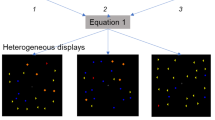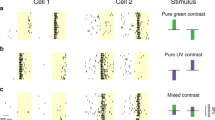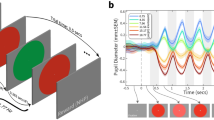Abstract
IT has been argued by Watson, Barlow and Robson1 that the visual stimulus that humans detect best specifies the spatial-temporal structure of the receptive field of the most sensitive visual neurons. To investigate ‘what the eye sees best’ they used stimuli that varied in luminance alone. Because the most abundant primate retinal ganglion cells, the P cells, are colour-opponent2–4, we might expect that a coloured pattern would also be detected well. We generalized Watson et al.'s study1 to include variations in colour as well as luminance. We report here that our best detected coloured stimulus was seen 5–9-fold better than our best luminance spot and 3–8-fold better than Watson's best luminance stimulus. The high sensitivity to colour is consistent with the prevalence and high colour contrast-gain of retinal P cells, and may compensate for the low chromatic contrasts typically found in natural scenes.
This is a preview of subscription content, access via your institution
Access options
Subscribe to this journal
Receive 51 print issues and online access
$199.00 per year
only $3.90 per issue
Buy this article
- Purchase on Springer Link
- Instant access to full article PDF
Prices may be subject to local taxes which are calculated during checkout
Similar content being viewed by others
References
Watson, A. B., Barlow, H. B. & Robson, J. G. Nature 302, 419–422 (1983).
Gouras, P. J. Physiol., Lond. 199, 533–547 (1968).
Perry, V. H. & Cowey, A. Vision Res. 25, 1795–1810 (1985).
Perry, V. H., Oehler, R. & Cowey, A. Neuroscience 12, 1101–1123 (1984).
Williams, D, R., MacLeod, D. I. A. & Hayhoe, M. H. Vision Res. 21, 1341–1356 (1981).
Cole, G. R., Stromeyer, C. F. III & Kronauer, R. E. J. opt. Soc. Am. A7, 128–140 (1990).
Watson, A. B. & Pelli, D. G. Percept. Psychophys. 33, 113–120 (1983).
Noorlander, C., Heuts, M. J. G. & Koenderink, J. J. opt. Soc. Am. 71, 453–459 (1981).
Stromeyer, C. F. III, Cole, G. R. & Kronauer, R. E. Vision Res. 25, 219–237 (1985).
Thornton, J. E. & Pugh, E. N. Jr Science 219, 191–193 (1983).
Lee, B. B., Martin, P. R. & Valberg, A. J. Physiol., Lond. 414, 223–243 (1989).
Derrington, A. M., Krauskopf, J. & Lennie, P. J. Physiol., Lond. 357, 241–265 (1984).
Stromeyer, C. F. III, Cole, G. R. & Kronauer, R. E. Vision Res. 37, 1113–1137 (1987).
van Trees, H. L. Detection, Estimation, and Modulation Theory (Wiley, New York, 1968).
Pelli, D. G. in Vision: Coding and Efficiency (ed Blakemore, C.) (Cambridge Univ. Press, Cambridge, 1990).
Mullen, K. J. Physiol., Lond. 359, 381–400 (1985).
King-Smith, P. E. & Carden, D. J. opt. Soc. Am. 66, 709–717 (1976).
Kelly, D. H. & van Norren, D. J. opt. Soc. Am. 67, 1081–1091 (1977).
Smith, V. C., Bowen, R. W. & Pokorny, J. Vision Res. 24, 653–660 (1984).
Reid, R. C. & Shapley, R. M. Nature 356, 716–718 (1992).
Schein, S. J. J. comp. Neurol. 269, 479–505 (1988).
Hirsch, J. & Curcio, C. C. Vision Res. 29, 1095–1101 (1989).
Troy, J. B. & Lee, B. B. Invest. Ophthalmol. Vis. Sci. 32 (suppl.), 905 (1991).
Crook, J. M., Lange-Malecki, B., Lee, B. B. & Valberg, A. J. Physiol., Lond. 396, 205–224 (1988).
Shapley, R. M., Reid, R. C. & Kaplan, E. Invest. Ophthalmol. Vis. Sci. 32 (suppl.), 115 (1991).
Purpura, K., Kaplan, E. & Shapley, R. M. Proc. natn. Acad. Sci. USA 85, 4534–4537 (1988).
Derrington, A. M. & Lennie, P. J. Physiol., Lond. 357, 219–240 (1984).
Kaplan, E., Lee, B. B. & Shapley, R. M. in Progress in Retinal Research Vol. 9 (eds Osborne, N. & Chader, J.) (Pergamon, Oxford, 1990).
Author information
Authors and Affiliations
Rights and permissions
About this article
Cite this article
Chaparro, A., Stromeyer, C., Huang, E. et al. Colour is what the eye sees best. Nature 361, 348–350 (1993). https://doi.org/10.1038/361348a0
Received:
Accepted:
Issue Date:
DOI: https://doi.org/10.1038/361348a0
This article is cited by
-
Melanopic stimulation does not alter psychophysical threshold sensitivity for luminance flicker
Scientific Reports (2021)
-
Improved visual sensitivity during smooth pursuit eye movements
Nature Neuroscience (2008)
-
Disclosing disease mechanisms with a spatio-temporal summation paradigm
Graefe's Archive for Clinical and Experimental Ophthalmology (2006)
-
Visually guided movements to color targets
Experimental Brain Research (2006)
-
Chromatic-Spatial Vision of the Aging Eye
Optical Review (2004)
Comments
By submitting a comment you agree to abide by our Terms and Community Guidelines. If you find something abusive or that does not comply with our terms or guidelines please flag it as inappropriate.



